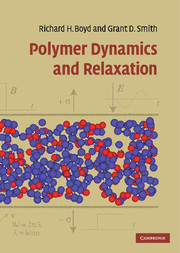10 - Miscible polymer blends
Published online by Cambridge University Press: 10 November 2009
Summary
Polymer blends account for about 40% of all polymers produced [1]. Miscible polymer blends are technologically important because they have the potential to lead to new materials without the expense and time of new synthesis. Like the metal alloys that preceded them, polymer blends often benefit from synergistic effects that make them more useful than a simple linear combination of properties would anticipate. The importance of miscible polymer blends is likely to increase as a result of environmental and economic pressures. Growth areas for miscible polymer blends include recycled polymers where understanding of and the ability to improve the properties of mixtures of post-consumer polymers could greatly increase the utility of these materials. Furthermore, use of miscible polymer blends for drug delivery and biomedical applications, where blending of materials already approved for in vivo applications in order to achieve improved properties without the time and expense associated with obtaining approval for use of new polymer materials, is receiving increased attention. An improved understanding of miscible blends may also ultimately have significant impact on our understanding of other dynamically heterogeneous polymer systems such as polymer nanocomposites, microphase separated polymer blends, and polymers in confined environments.
The ability to understand, and ultimately to predict, the behavior of miscible polymer blends based upon the behavior of the pure component polymers that make up the blend is central to our ability to design polymer mixtures with desired properties.
- Type
- Chapter
- Information
- Polymer Dynamics and Relaxation , pp. 227 - 243Publisher: Cambridge University PressPrint publication year: 2007

